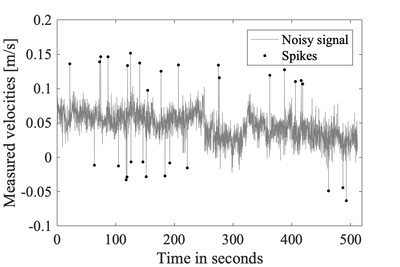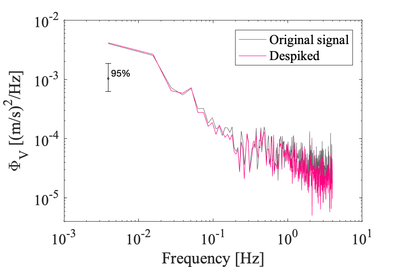Velocity despiking: Difference between revisions
m Added another explanatory sketch |
|||
| Line 20: | Line 20: | ||
===Filter based methods=== | ===Filter based methods=== | ||
[[File:Smoothed velocities.png|thumb|none|400px|Example velocities before and after smoothing. | [[File:Smoothed velocities.png|thumb|none|400px|Example velocities before and after smoothing. Filter-based despiking methods use the difference between these two signals to identify spikes.]] | ||
===Phase-space thresholding methods=== | ===Phase-space thresholding methods=== | ||
Revision as of 20:18, 24 November 2021
{{#default_form:Processing}}
{{#arraymap:
Velocity point-measurements
|,|x||}}
{{#arraymap:level 1 raw|,|x||}}
Overview
Any measured signal may be contaminated by spikes. These spikes are typically short-lived and transient, which result in sudden change in the measured velocities.
Spikes in velocities measured by acoustic-Doppler velocimeters can result from aliasing of the Doppler signal, in particular when pulses become contaminated by reflecting from complex objects and boundaries [1]. These spikes must be removed because they can alter quite dramatically the velocity spectra, which is then used for fitting inertial subrange model.
-

Example velocities measured by an acoustic-Doppler velocimeters -

Example velocity spectra before and after removing spikes. The variance of the despiked signal has reduced by 12% even though there were 30 spikes
Despiking methods
Several techniques exist for despiking. The most used with acoustic-Doppler velocimeters are the phase-space thresholding techniques [1]. Other techniques currently being investigated by the subgroup are those used in atmospheric turbulence studies [2], in particular the median filter despiking technique [3], which derives its threshold for identifying spurious spikes from the data itself.
Filter based methods

Phase-space thresholding methods
Elaborate a bit? Or include information in a separate page
Notes
- ↑ 1.0 1.1 {{#arraymap:D. G. Goring and V.I. Nikora|,|x|x|, |and}}. 2002. Despiking Acoustic Doppler Velocimeter Data. Journal of Hydraulic Engineering. doi:10.1061/ASCE0733-94292002128:1117
- ↑ {{#arraymap:D. Starkenburg, S. Metzger, G.J. Fochesatto, J.G Alfieri, R. Gens, A. Prakash and J. Cristobal|,|x|x|, |and}}. 2016. Assessment of Despiking Methods for Turbulence Data in Micrometeorology. J. Atmos. Oceanic Technoly. doi:10.1175/JTECH-D-15-0154.1
- ↑ {{#arraymap:F.V. Brock|,|x|x|, |and}}. 1986. A nonlinear filter to remove impulse noise from meteorological data. J. Atmos. Oceanic Technoly. doi:10.1175/1520-0426(1986)003,0051:ANFTRI.2.0.CO;2
